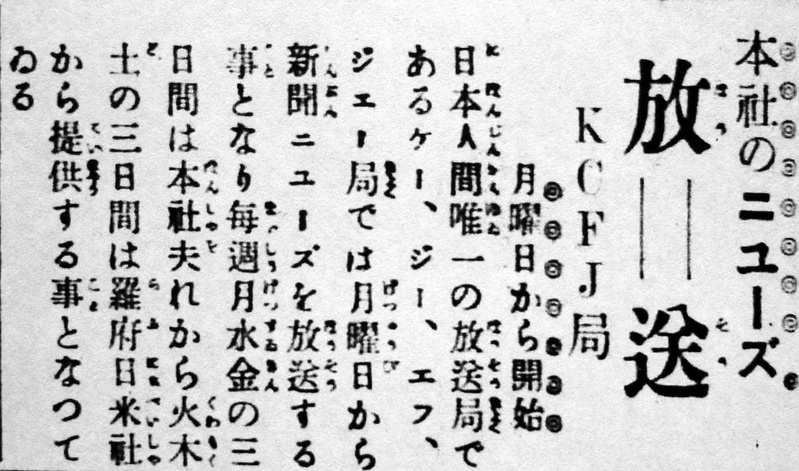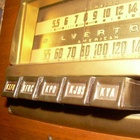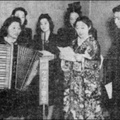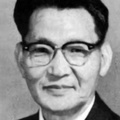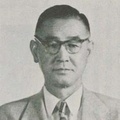
In 1930, the long-awaited first regular Japanese broadcasting began in Los Angeles. It was the "Japanese Broadcasting Station" (or Japanese Language Broadcasting Station), presided over by Utah-born Kazumasa Kawachi. It began on April 28, 1930. It aired for 30 minutes from noon Monday through Saturday on KGFJ.
The announcements were made by Kanda Koichi, a graduate student of political science at the University of Southern California. Described as "a passionate orator, enthusiastic, and caring person" (Rafu Nichibei, August 22, 1932), Kanda used his eloquence and academic background to serve as a member of the Aichi Prefectural Assembly and its chairman after the war.
The first week's program was announced as "Shitamachi Bigatari Ren" broadcasting folk songs and Nagauta, with titles such as "Yasugi Bushi" (Hamanoie Aiko, Natsuko), Nagauta (Hamanoie Kimiko), and "Sutton Bushi" (Kawafuku Maruko). Both Hamanoie and Kawafuku were the names of restaurants in Los Angeles at the time. Geisha who performed in the Japanese-style restaurant parlors showed off their skills.
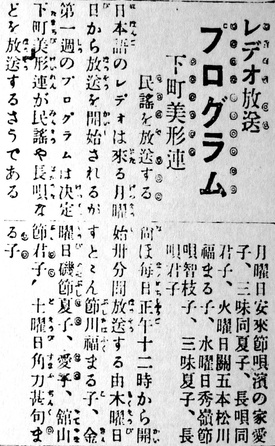
Incidentally, the level of her talent can be seen from the fact that Kawafuku Maruko appeared with other geisha on a radio program on KGER, which was organized as part of the Japan Day event at the Pacific Southwest Exposition held in Long Beach in 1928. Such radio appearances by geisha were common in Japanese language programs all over the west coast of the United States, from Vancouver to Los Angeles.
Initially, the programming was mainly music, but over time it was expanded to include an astonishing variety of content. First, in May, with the cooperation of a local Japanese newspaper, a new news program was launched. The Rafu Shimpo provided material on Mondays, Wednesdays and Fridays, while Rafu Nichibei provided material on Tuesdays, Thursdays and Saturdays. Next, they also started working on radio dramas such as "Konjiki Yasha" and "Hototogisu."
Also, a film story was started, which seems to have been tied up with Fujikan, a theater specializing in screenings of Japanese films. This is a film commentary that combines music with the story and dialogue of the film, and silent film narrators such as Hosokawa Tenryu, Hokutosai Kenyu, Fujioka Ginba, and Kunimoto Kido, who were active at Fujikan, can be seen making appearances.
On Saturdays, a children's program was scheduled. The program was arranged by the Los Angeles branch of the Shinsekai Shimbun and began airing at the end of June. It was handled by a reporter from the same branch, Mito Aikawa (Norimichi). Mito studied at the University of Southern California, and after returning to Japan, he focused on writing children's books such as fairy tales and on early childhood education.
Although the details are unclear, on July 18, 1955, the station was changed to KFVD in Culver City, and the broadcast time was changed to Friday evenings from 9:15 to 10:00 p.m. Kyodo Izutsu (Shiro), a teacher of the Kinko-ryu shakuhachi, was invited to serve as the new music director, and Kunimoto Terudo took over as the announcer. From a modern perspective, it seems odd that a leading figure in the shakuhachi world would serve as music director, but it seems that this was a selection that was only possible at the time when Japanese music was at its peak. On the first day of the change, the program aired Nagauta pieces "Renjishi" and "Chikuma River" (by master Kineya Yasoyo), harmonica performance (Saito Susumu), and shigin (Anzai Shusui).
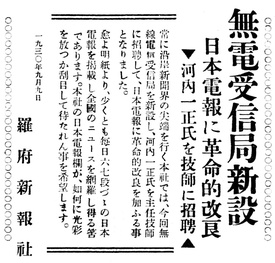
However, they received a notice stating that "We will decline to use the station due to the lack of interest from Caucasian viewers and the large number of complaints" (Rafu Shimpo, July 26, 1930), and the broadcast ended after just one day. The hopeful change of station ended up completely backfiring.
Incidentally, the year 1930 was a memorable one for the Japanese community living abroad, as another Japanese language program planned in November by the Teikoku Trading Company and Kataoka Watch Shop was cancelled due to opposition from the broadcasting station.
Although Kawachi never got involved in Japanese language broadcasting after that, he made a significant contribution to the Japanese community behind the scenes. In September 1955, the Rafu Shimpo established a new wireless telegraph receiving station in Redondo Beach to receive news telegrams sent from Japan, and invited Kawachi to work as a radio engineer. The news Kawachi received was headlined "Important Telegrams Received from Head Office Wireless Station" and made headlines on the front page every day. Incidentally, the "Head Office Wireless Station" was actually an amateur radio facility that Kawachi had installed as a hobby in his home.
*This article is an excerpt from Japan Hour (2020) and reprinted from The Rafu Shimpo (April 20, 2021).
© 2022 Tetsuya Hirahara


